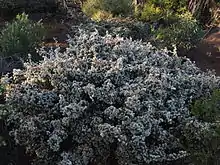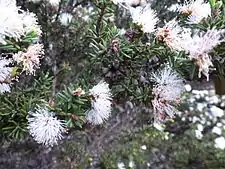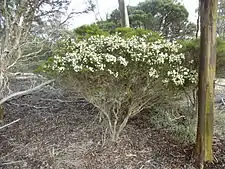Melaleuca bromelioides
Melaleuca bromelioides is a plant in the myrtle family, Myrtaceae and is endemic to the south-west of Western Australia. It has distinctive, pine-like, prickly leaves and flowers that change colour from white to reddish as they age.
| Melaleuca bromelioides | |
|---|---|
 | |
| M. bromelioides growing near Ravensthorpe | |
| Scientific classification | |
| Kingdom: | Plantae |
| Clade: | Tracheophytes |
| Clade: | Angiosperms |
| Clade: | Eudicots |
| Clade: | Rosids |
| Order: | Myrtales |
| Family: | Myrtaceae |
| Genus: | Melaleuca |
| Species: | M. bromelioides |
| Binomial name | |
| Melaleuca bromelioides Barlow | |
Description
Melaleuca bromelioides is a shrub to about 1.0–1.5 m (3–5 ft) high with mostly glabrous foliage and branches. Its leaves are crowded and pine-like, about 7–13 mm (0.3–0.5 in) long and 1 mm (0.04 in) wide, linear or narrow oblong and tapering to a sharp point.
The flowers are white when young but turn reddish as they age. They are in heads at or near the ends of the branches which continue to grow after flowering. Each head contains 2 to 10 individual flowers and is about 15–20 mm (0.6–0.8 in) in diameter. Flowers appear in September and October and the fruit which follow are cylindrical or barrel-shaped woody capsules which retain the sepals as teeth around the edge. The fruit are 5–6 mm (0.20–0.24 in) long and 4–5 mm (0.16–0.20 in) in diameter.[1][2]


Taxonomy and naming
Melaleuca bromelioides was first formally described in 1988 by Bryan Barlow in Australian Systematic Botany from a specimen found near Lake King.[3][4] The specific epithet (bromelioides) is a reference to the similarity of its flowers to the bromeliad growth form.[2]
Distribution and habitat
This melaleuca is confined to the Esperance region in a narrow strip between Lake King to Mount Heywood[1] in the Coolgardie, Esperance Plains and Mallee biogeographic regions of Western Australia.[5] It grows in sandy or clayey soils on flats[6] in a range of vegetation associations including mallee, eucalypt woodland and scrubland.[2]
Conservation status
Melaleuca bromelioides is classified as "not threatened" by the Government of Western Australia Department of Parks and Wildlife.[5]
References
- Holliday, Ivan (2004). Melaleucas : a field and garden guide (2nd ed.). Frenchs Forest, N.S.W.: Reed New Holland Publishers. pp. 36–37. ISBN 1876334983.
- Brophy, Joseph J.; Craven, Lyndley A.; Doran, John C. (2013). Melaleucas : their botany, essential oils and uses (PDF). Canberra: Australian Centre for International Agricultural Research. p. 99. ISBN 9781922137517. Retrieved 16 March 2015.
- "Melaleuca bromelioides". APNI. Retrieved 16 March 2015.
- Barlow, BA; Cowley, KJ (1988). "Contributions to a revision of Revision of Melaleuca (Myrtaceae): 4-6". Australian Systematic Botany. 1 (2): 112. doi:10.1071/SB9880095.
- "Melaleuca bromelioides". FloraBase. Western Australian Government Department of Parks and Wildlife.
- Paczkowska, Grazyna; Chapman, Alex R. (2000). The Western Australian flora : a descriptive catalogue. Perth: Wildflower Society of Western Australia. p. 392. ISBN 0646402439.